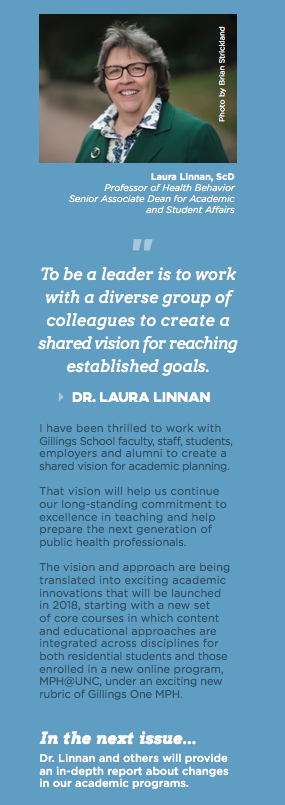How can we be intrepid public health leaders?
October 15, 2017
Amy Lansky, PhD
Alumna, health behavior (MPH, 1991; PhD, 1996)

Dr. Amy Lansky (Contributed photo)
As we move further into the 21st century, consider this:
- Technology will advance in ways we may not predict.
- Public health will not be immune to fluctuations in politics, economics and law.
- Social and environmental factors will have an impact upon the public’s health.
In the face of uncertainty, leaders can rely on foundational skills related to priority-setting, use of data and sustaining partnerships. Applying these skills within the context of national strategies to guide specific public health issues enhances the potential for impact, even in the face of changes in the broader environment in which we lead.
Most public health issues are complex, and data may be contradictory or evolving. It is a leader’s job to determine the way forward – to make choices and define priorities.
The power to make a difference at a national level requires setting national priorities, driving sustained complementary efforts toward a few (three to five) priority goals that cascade to the state and local levels.
Some examples of this are the National HIV/ AIDS Strategy (tinyurl.com/HRSA-HIV-AIDS), the National Viral Hepatitis Action Plan (tinyurl.com/cdc-hepatitis-plan) and the National Strategy for Combatting Antibacterial Resistant Bacteria (tinyurl.com/cdc-ARB-strategy).
With a national strategy as a guide, leaders determine which goals, strategies and actions maximize their capacity to address the burden or disparities that characterize their jurisdiction.
 Critical data skills for public health leaders are those that help them both understand and use data. Increased availability of all kinds of data – and novel ways to use information – means that leaders will need to know what data to ask for to inform the decisions they are required to make.
Critical data skills for public health leaders are those that help them both understand and use data. Increased availability of all kinds of data – and novel ways to use information – means that leaders will need to know what data to ask for to inform the decisions they are required to make.
Leaders will be expected to see trends and ask tough questions – Why is the trend going up (or down)? Why is the rate of change slow (or fast)? Where is the trend headed next? How do we accelerate the rate of change to achieve the greatest and fastest impact? Indicators to measure progress are an integral part of national strategies.
Leaders will need skills to identify appropriate outcome and performance measures and use the data to communicate progress accurately and transparently. Communicating about priorities and progress means using the data to tell stories about people and communities – numbers reflect underlying stories and those stories reflect people. In these ways, data inspire continued action and commitment toward achieving the priorities identified in national strategies.
Using national strategies to accelerate progress and increase the impact of public health action requires strong partnerships. Having the skills to cultivate partnerships is enhanced by having the will to do so – the deliberate intention to engage meaningfully with others.
Many of the national strategies noted above were developed and implemented by engagement at all levels – among federal agencies, between federal agencies and their state and local government and nongovernmental partners, and with communities. Building, sustaining and leveraging partnerships requires creativity and persistence. Relying on national strategies with clearly prioritized health outcomes, defined targets for measuring progress, and compelling data to illustrate need and direction can help attract and energize even the most (seemingly) incongruous or unwilling partners.
The pace of change in the environment in which public health leaders operate is likely to move faster over the next several decades. Having the vision to drive toward a small set of priority outcomes that are data-based and supported by stakeholders at all levels will be key to improving the public’s health through the remainder of the 21st century.
Amy Lansky, PhD, is a senior adviser for strategy in the Program Performance and Evaluation Office at the Centers for Disease Control and Prevention. She formerly served as director of the White House Office on National AIDS Policy.
This article was written by Amy Lansky in her private capacity. No official support or endorsement by the Centers for Disease Control and Prevention, Department of Health and Human Services, is intended, nor should be inferred.
Lansky was selected as one of UNC’s Distinguished Alumni for 2017 and was recognized at University Day festivities on Oct. 12.
Carolina Public Health is a publication of the University of North Carolina at Chapel Hill Gillings School of Global Public Health. To view previous issues, please visit sph.unc.edu/cph.
